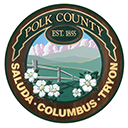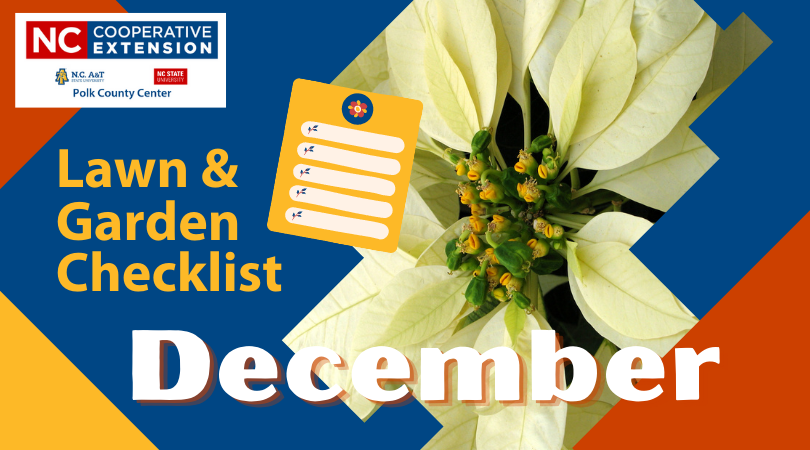Polk County Lawn & Garden Checklist for December
go.ncsu.edu/readext?834213
en Español / em Português
El inglés es el idioma de control de esta página. En la medida en que haya algún conflicto entre la traducción al inglés y la traducción, el inglés prevalece.
Al hacer clic en el enlace de traducción se activa un servicio de traducción gratuito para convertir la página al español. Al igual que con cualquier traducción por Internet, la conversión no es sensible al contexto y puede que no traduzca el texto en su significado original. NC State Extension no garantiza la exactitud del texto traducido. Por favor, tenga en cuenta que algunas aplicaciones y/o servicios pueden no funcionar como se espera cuando se traducen.
Português
Inglês é o idioma de controle desta página. Na medida que haja algum conflito entre o texto original em Inglês e a tradução, o Inglês prevalece.
Ao clicar no link de tradução, um serviço gratuito de tradução será ativado para converter a página para o Português. Como em qualquer tradução pela internet, a conversão não é sensivel ao contexto e pode não ocorrer a tradução para o significado orginal. O serviço de Extensão da Carolina do Norte (NC State Extension) não garante a exatidão do texto traduzido. Por favor, observe que algumas funções ou serviços podem não funcionar como esperado após a tradução.
English
English is the controlling language of this page. To the extent there is any conflict between the English text and the translation, English controls.
Clicking on the translation link activates a free translation service to convert the page to Spanish. As with any Internet translation, the conversion is not context-sensitive and may not translate the text to its original meaning. NC State Extension does not guarantee the accuracy of the translated text. Please note that some applications and/or services may not function as expected when translated.
Collapse ▲For more info, help, and advice on these or other lawn and garden topics, contact your Polk County Extension Director, Scott Welborn.
When selecting poinsettias, look for plants with yellow flowers in the centers of the colored leaves (bracts) that are not quite open. Tight flower buds are a good indication that the plant is fresh and healthy. Once you bring your poinsettia home, keep it in an area that receives bright light and has a constant temperature of about 65-70°F. Keep poinsettias away from doorways or other areas that are drafty such as heat vents. Keep them well watered but not over watered. Mistletoe should be kept away from children and pets in your home. The berries of mistletoe are toxic.
Winter is a stressful time for plants due to low humidity and cold winds. Take the time to mulch them well and protect those tender plants with row covers. Do not fertilize plants with a nitrogen fertilizer in the winter and hold off pruning plants until the coldest part of winter is over. This will allow you more options when trying to recover a plant that has been severely cold or ice damaged. Be sure to keep evergreen plants moist during dry periods. Plants in pots are prone to die when the pot freezes. Be sure to move those potted plants into a protected area if a deep freeze is expected and keep them well watered.
Bird feeders should be cleaned monthly with hot sudsy water to prevent the spread of wild bird diseases.
Follow these suggestions to reduce the risk of a fire hazard caused by a Christmas tree in the home:
- Keep the tree in a bucket of water, in a shady location outdoors or in an unheated room until you are ready to place it inside.
- Re-cut the butt of the tree to make a new avenue for water entry immediately prior to placing in your tree stand and bringing it indoors
- While indoors, keep watered at all times.
- The tree needs only fresh water; additives are of little or no value.
- Keep the tree away from heat vents as they will prematurely dry the tree out.
Now is the time to be spraying and pulling all the winter weeds such as chickweed and henbit. These will produce millions of seeds if not destroyed before they flower! Ordinary weed killers will work well in the winter on days that reach above 50 degrees. You may just have to wait a little longer for them to die due to the reduced activity of the plants.
If your fall over-seeding didn’t fill in the lawn as fully as you had expected, you can still apply a little extra seed to those thin spots. The seed will come up slowly over the winter and should be filled in fully by spring. A late fall lawn fertilization is important. This is typically done in late November, but if you forgot about it you can do it now.
Harvest those last heads of cabbage and broccoli soon, because they can be damaged by temperatures below 26 degrees. Root crops can remain in the ground all winter if a good layer of mulch is applied. If you haven’t planted a cover crop by this time, do that right away. Annual ryegrass will germinate quickly and grow well in the cool environment. You may also want to prepare a few beds now for spring planting just in case we have a very wet winter and you can’t work the soil early in the season.
NOTE: The use of brand names in this publication does not imply endorsement by the North Carolina Cooperative Extension Service of the products or services named nor discrimination against similar products or services not mentioned.





